Ironclaw by Little Blackfly
Totally Not About Furries
Original SA post Ironclaw: Totally not about FurriesSo, I know I'm doing a write-up of Aberrant (slowly) but I just had to expose people to this. How I found out about it involved some friends of mine, bronies all, discussing doing an MLP roleplay, using a system I had never heard of. I set about finding a copy of the rules.
What I found was:
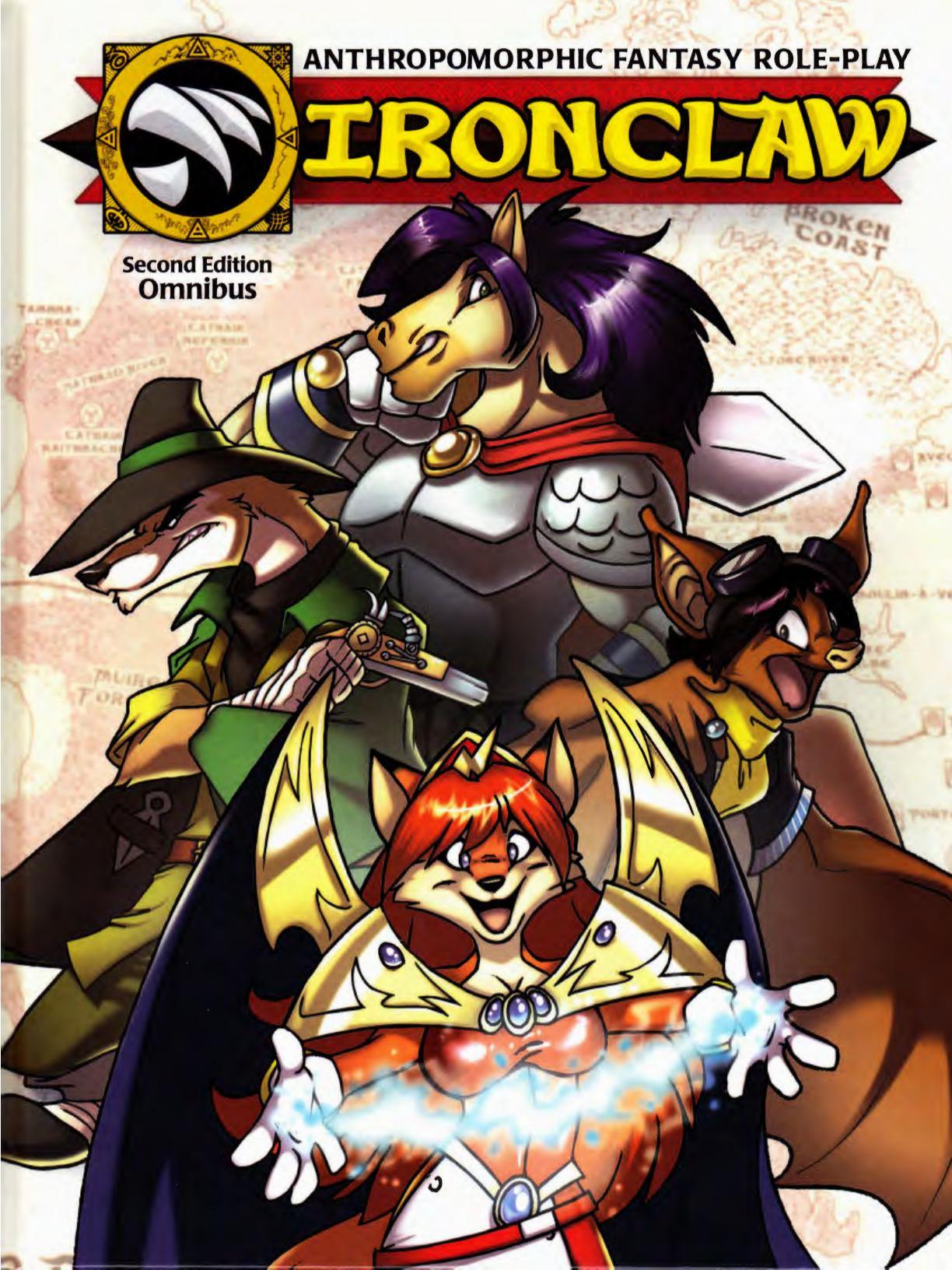
The revelation that my friends knew about this system was a bit of a shock. They've always been waaaaayyyyy more into tabletop games than I am. I've only been in a few campaigns in total, some of these friends participate in 3 or 4 games per week. So hopefully they knew about Ironclaw because of that, and not because they are closet furries. Though who knows.
Set in what appears to be, from my initial reading, a fantasy analogue of renaissance Europe (only full of furries) called Calabria, Ironclaw is part of a trio of Anthropomorphic Roleplays released by a company called Sanguine Production. The other two in the series if anyone is wondering, are Jade Claw (Chinese/Japanese and East Asian setting) and Albedo (Sci-fi Setting). For what could have been an absolutely terrible abortion of a product, Ironclaw is actually pretty streamlined and polished as a system. It also really doesn’t seem to be a furry fetish product in intent, though I'm sure people are using it for that.
Character Creation, Part 1: Traits and Species Armadillos - Donkeys
The book starts off with a little introduction as to what a Roleplaying Game. Just your standard
 about GMs, players, characters and the like. It then jumps right into character creation.
about GMs, players, characters and the like. It then jumps right into character creation.
First we start by selecting our starting traits. There are six traits in Ironclaw: Body, Mind, Will, Speed, Species and Career . Ironclaw is a dice pool system, and at the beginning you get 1 d4, 3 d6s, and 2 d8 to allocate to your different traits. Each of these traits is also associated with a certain type of magic, so if you want to specialize in say, wind elemental magic, making sure to have a d8 in speed is good. Species and Career are interesting, they represent how good of a representative you are of your species and profession. A Cat with a d8 or greater in Species is one of the cattiest cats that ever catted, and will be far more bestial than a cat with d4 in body, who will be much closer to a furred human. Career is along the same lines, with better dice representing a greater focus or ability with the skills and trappings of a given class. If you get an extra career, possible through the "extra career" gift, this same dice will apply to all your careers.
So, my example character, who will be a wind elementalist, starts with the starting traits:
Body : d4
Mind :d6
Speed :d8
Will :d6
Species :d6
Career :d8
Next we pick species, and it is here that Ironclaw really starts to shine. Species and Careers in Ironclaw are like little packages of gifts (feats) and skill bonuses. You receive three gifts with each species, as well as your species dice to three different skills. You also get a habitat (which can grant you a a species dice as a bonus if your are in it), a diet (carnivore, herbivore, omnivore), Senses (which grant you a species dice bonus with the Observation skill if you are using the relevant sense to observe), a cycle (specifying whether your species is diurnal or nocturnal) and weapons, which are the natural weapons your species can fight with (claws, teeth, etc.)
Each species contains a description, a little stat box, and a surprisingly well done piece of art. The art is what really sells this stuff, I really love the details put into it
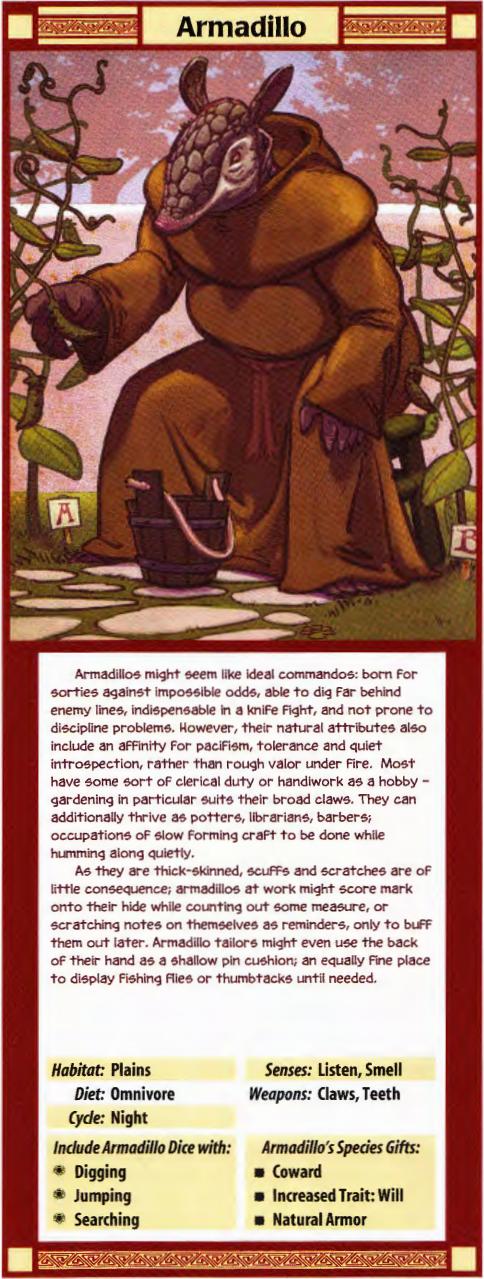
Armadillos are tough, but gentle. They tend towards pacifism and lives of quiet introspection.
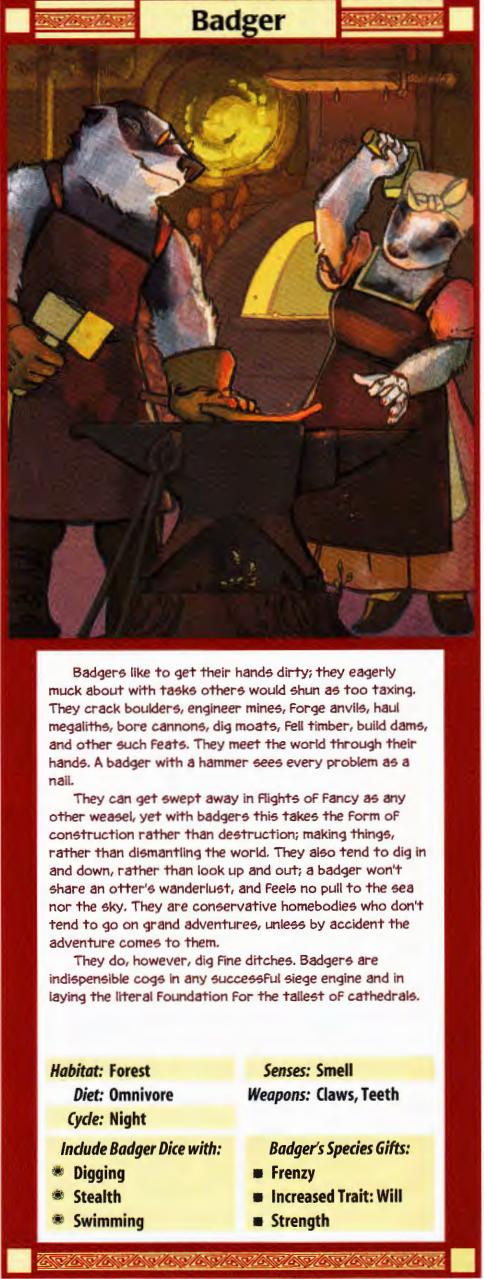
Badgers tend to favour manual labour and tasks other species find too hard. They tend to be conservative and are not very adventurous
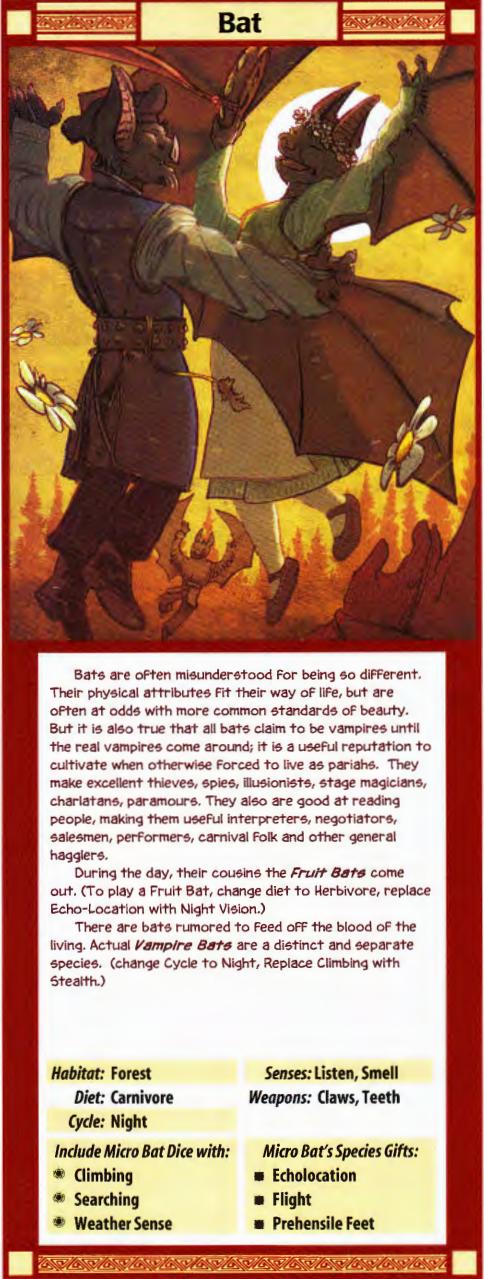
Bats are social pariahs due to their odd physiology. Some cultivate the perception of themselves as vampires (while some are vampires). Strangely, Bat is called Micro Bat in the trait descriptions, making me think Fruit Bats (or Flying Foxes) used to be a separate species, rather than a variant.
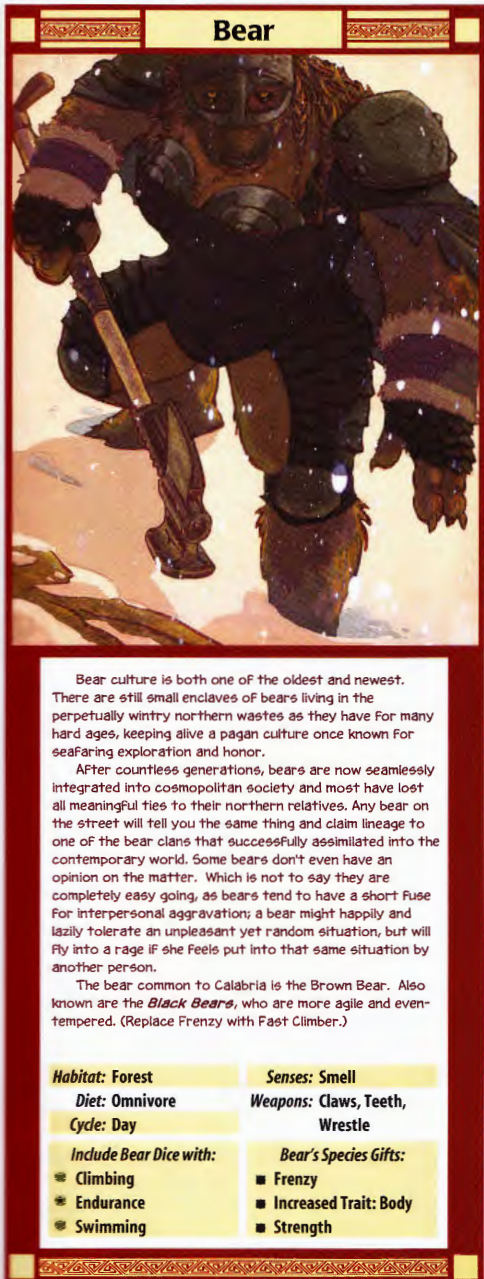
Bear are tribal barbarians from the north, some of whom have gradually melded into normal society.
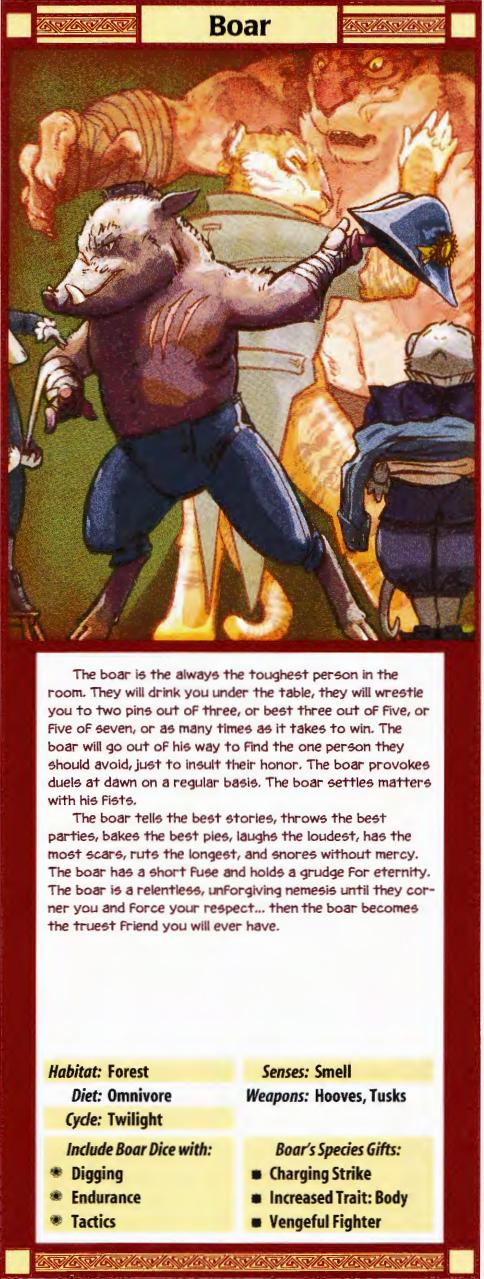
Boars are grizzled, stout warriors who solve everything with fighting and drink a lot. So boorish (
 ) thugs basically
) thugs basically
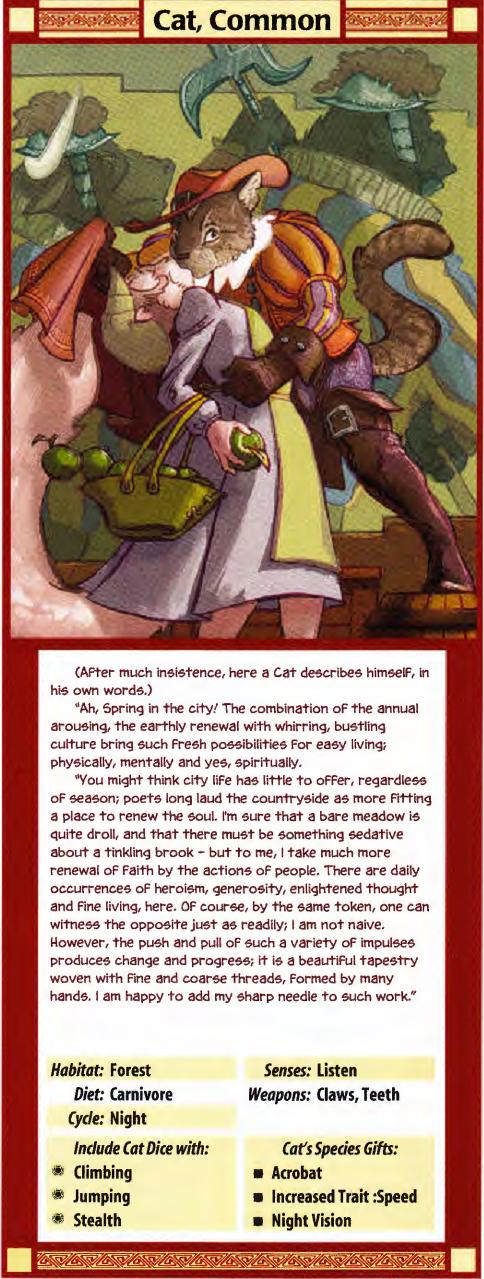
Cats are verbose and romantic, and like to use florid language.
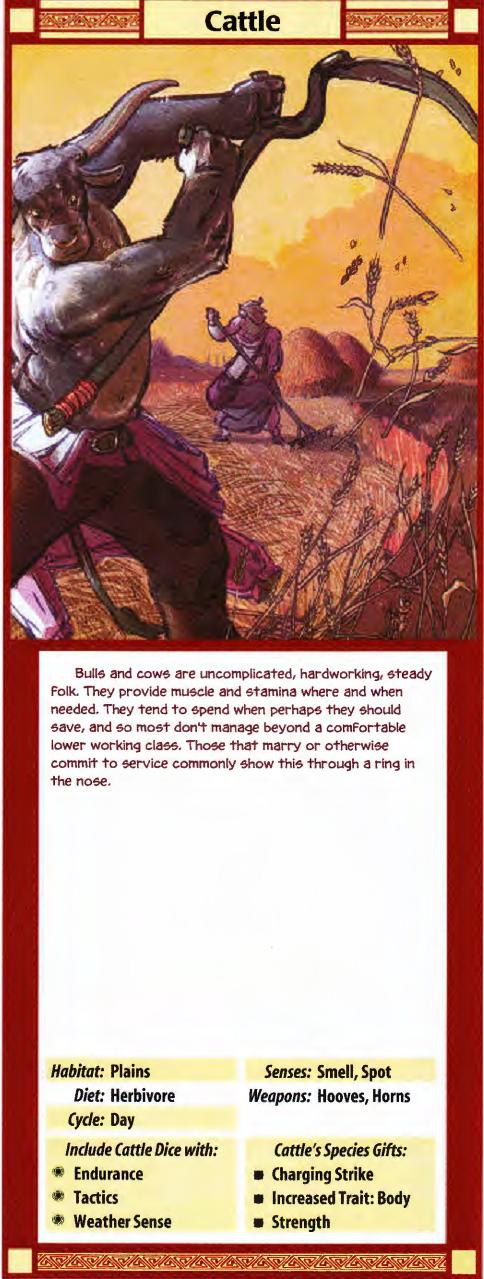
Cattle are simple and hard working, sort of the classic farmer archetype.
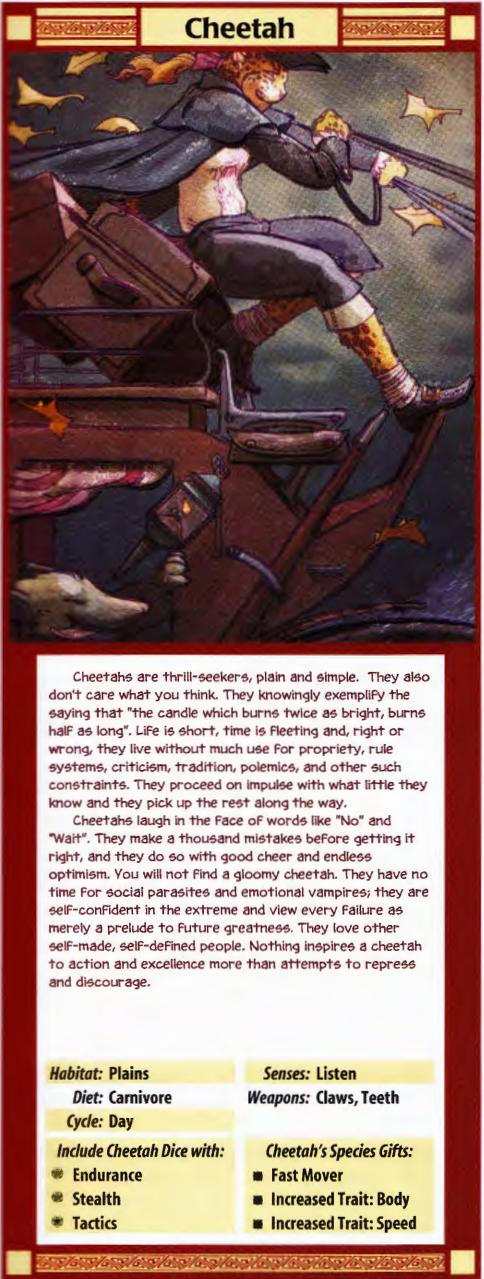
Cheetahs are thrill-seeking and reckless, and are extremly self-confident.
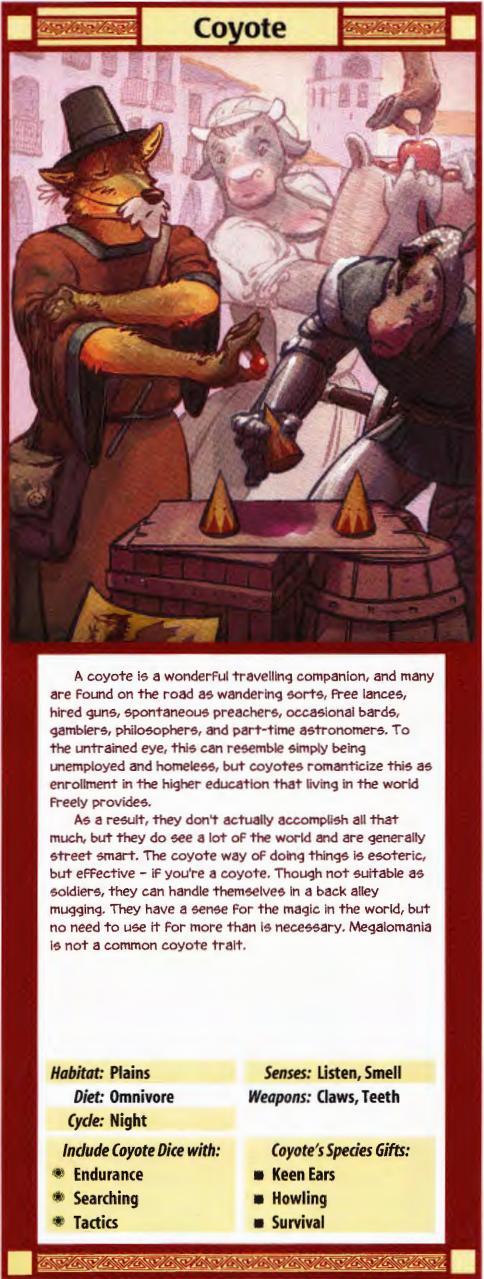
Coyotes are like are hucksters who sort of fill the "vagabond romantic" ideal of D&D bards.
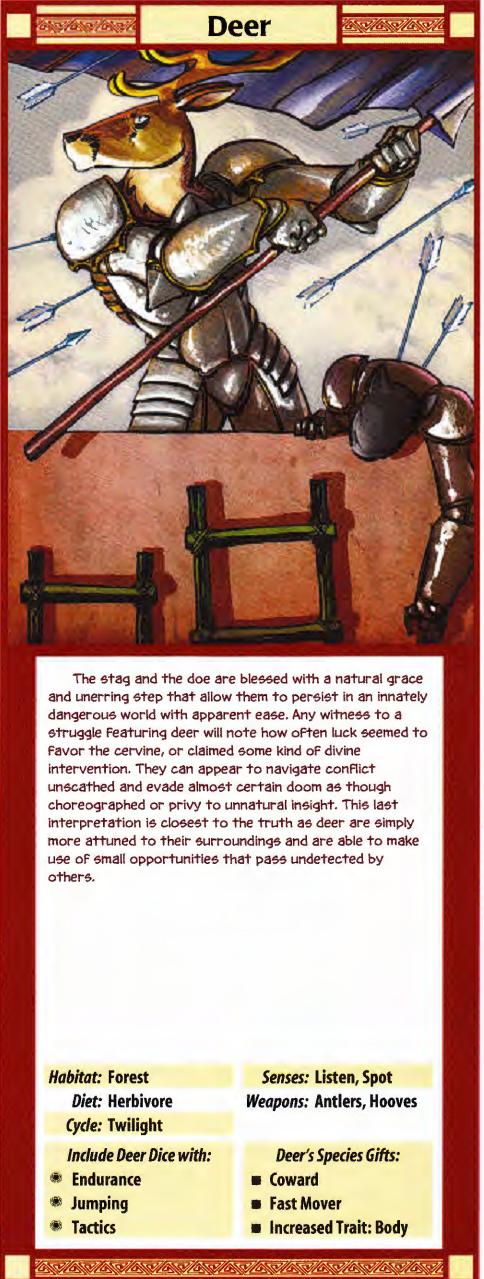
Deer are graceful warriors who seem blessed with unnatural luck, which really comes from their keen perception.
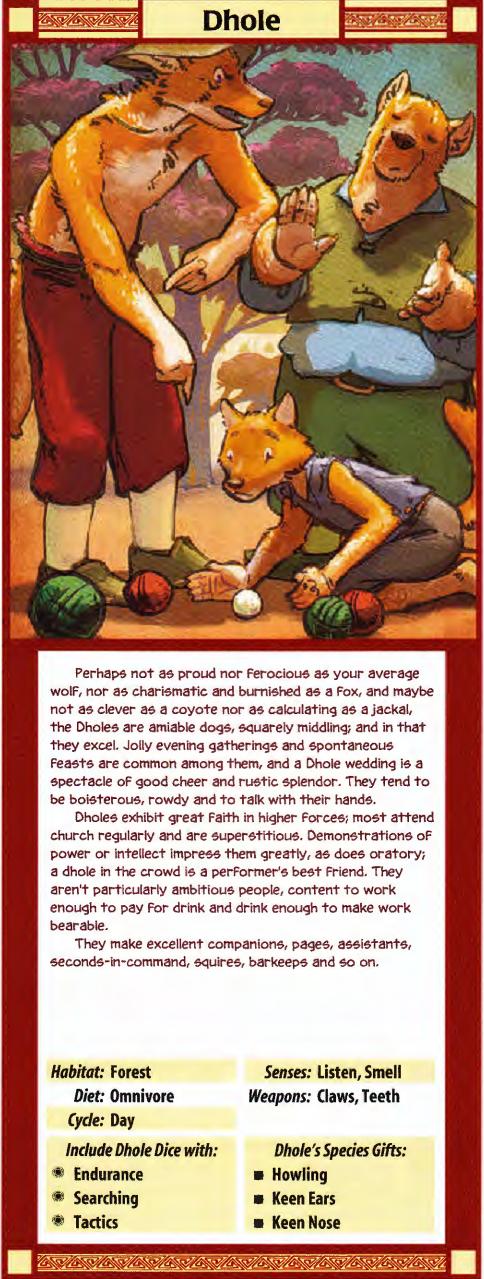
Dholes (or Indian Wild Dogs) are kind of your generic, god-fearing peasant archetype.
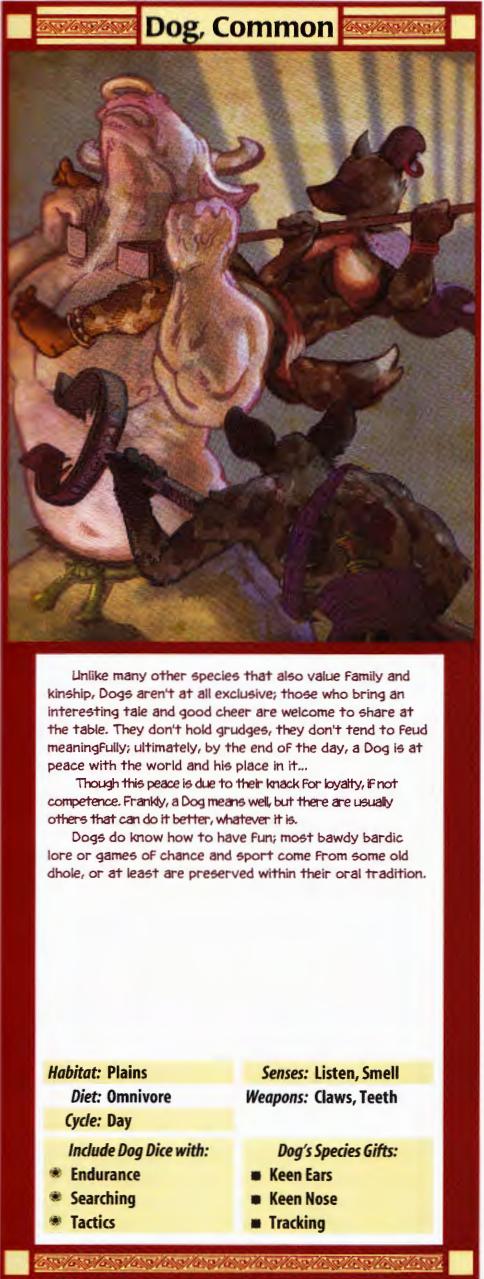
Dogs are generally friendly and accepting. They are generally competent, but excel at nothing. They're also extremely loyal. The image appears to be of dog slavers capturing a bull, so there's that too.
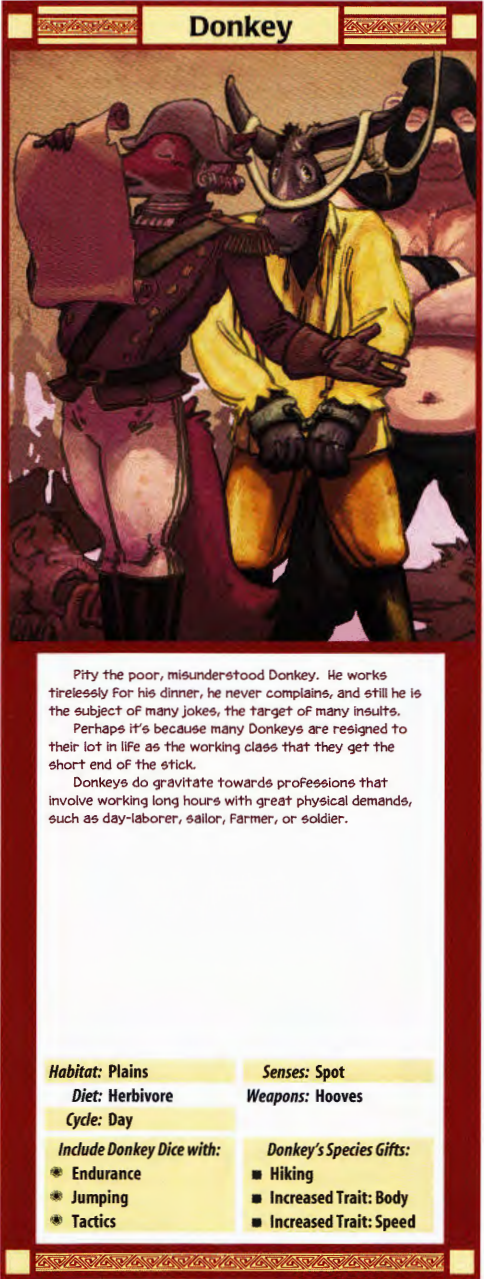
Donkeys are the species everybody picks on and the butt of everyone's jokes.
Next Time: Character Creation: Species Fox - Wolf, Careers
Mini-Combat/Art
Original SA postPurpleXVI posted:
Huh! This is interesting, from what I'd heard about Ironclaw I'd always figured it was basically just Fursona(i.e. a d20 supplement with dog dicks), I never actually realized it had its own system.
How does conflict/task resolution work? I mean, presumably you roll your die, but is there a standard TN? I wish to know more, because this sounds reasonably novel.
It works based on getting successes versus a specific number. For example, a skill check could require you to role Mind & Supernatural versus x; in which case, all the dice that came up with greater than x (not x or greater, mind you) would give successes. Difficulty varies in two ways, first on the number you have to hit (usually 3, so rolling 4 or more is a success) or in the number of successes you need. This type of difference in difficulty represents the difference between a really hard climb (difficult for even experienced climbers, so with a higher check, say versus 6) which would be impossible for people with too low dice to perform, and a craft or trade (which would require multiple successes, and hence would be easy for someone with a lot of dice in it) that would be impossible to do well without training, but easy to do with training.
Combat works via opposed checks to defenses, with any actual hits dealing penalties to the person (furry) hit. There's a bunch of different ways to counter or defend against attacks, so it's really not like the D&D "tis but a flesh wound" problem where people take an axe to the face and keep moving.
I just have to say that the layout of the book is really nice, it walks you through everything intuitively, so you basically learn the game as you would start trying to play a session. Much nicer than Aberrant.
As for creepy, CommissarMega, I see nothing too, too bad, a part form a few pieces of art:
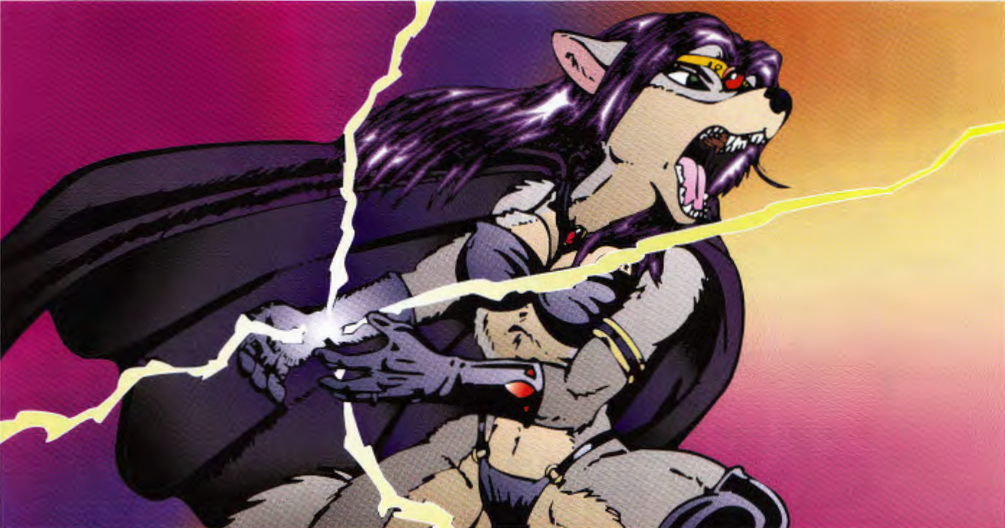
Right out of a furry Starfox fan's fantasies
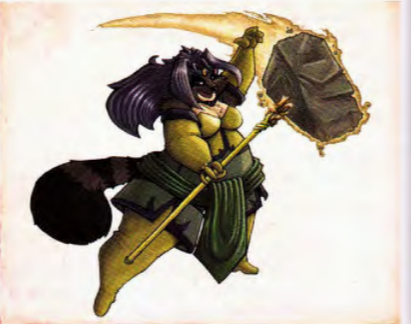
Just sorta weird lookin' in a fetishy sort of way
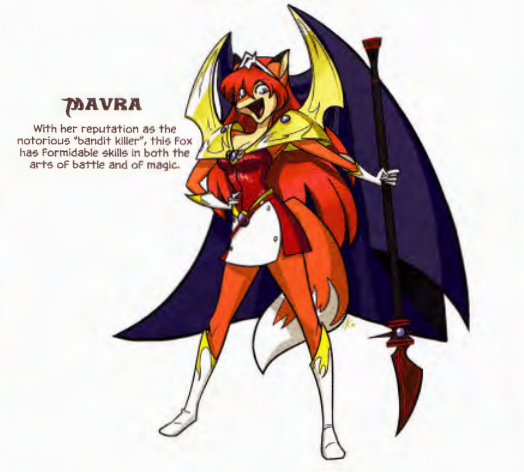
Totally not Lina Inverse
But they were more than made up for, by me discovering how Ironclaw got around the whole "Horses are people in a time when we used them as beasts of burden" problem:
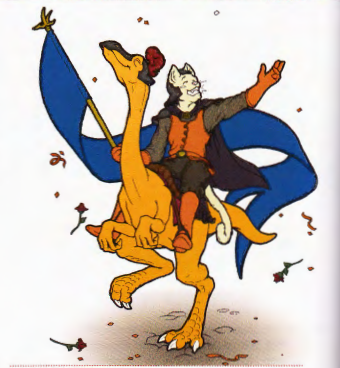
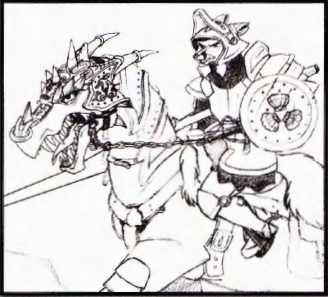
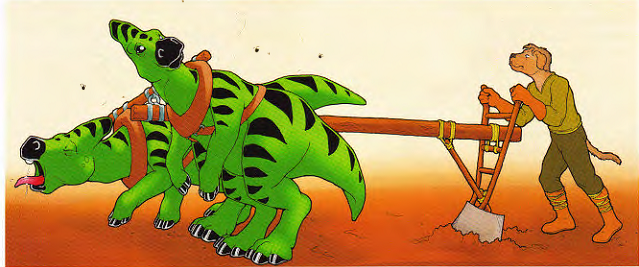
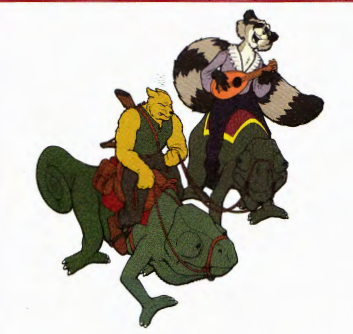
That's Right, Goddamn Dinosaurs. And Chameleons.
Also this guy:
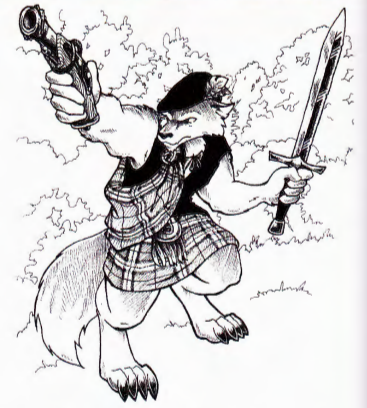
Fantasy Racial Stereotyping (with Furries)
Original SA post
You people are making me feel terrible. I don't understand how you can put together posts as fast as you do. I haven't looked at this thread in 3 days because I felt so guilty about not doing my write-ups.
With that out of the way, it's time for:
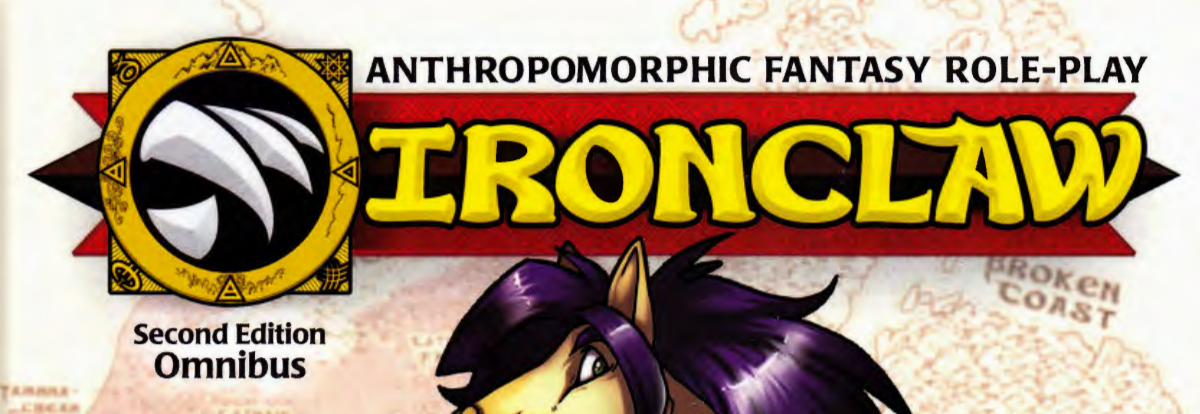
(I'm not photo-shopping out the horse head because
 )
)
Part 2: Fantasy Racial Stereotyping (with Furries)
I'm going to go through the rest of the species, just because I love the art for them so much. More fantasy race stereotyping ahoy! It feels like I'm reading Redwall again
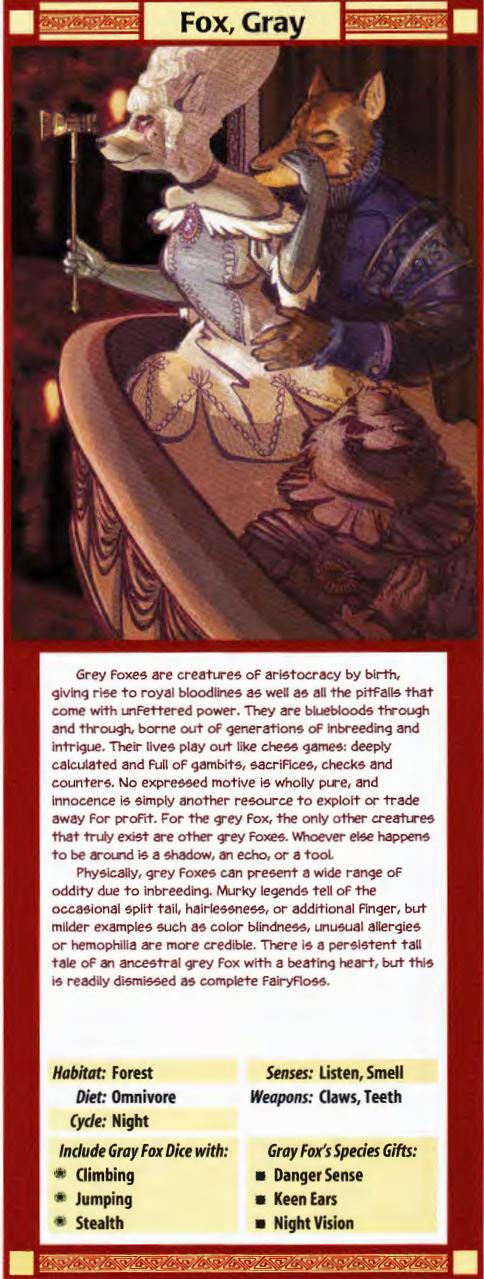
Gray Foxes
are the former rulers of the old empire that used to rule basically all of Calabria. They are stereotypical elitist bluebloods, who only care about other Gray Foxes
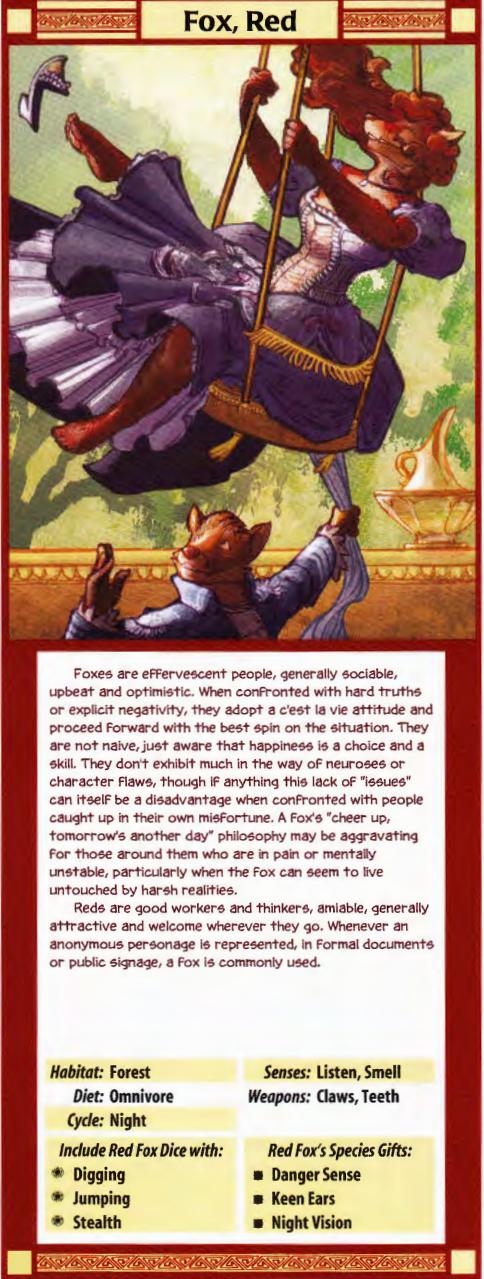
Red Foxes
are minor nobles form the old empire. They're much more relaxed about status and protocol than the gray foxes .
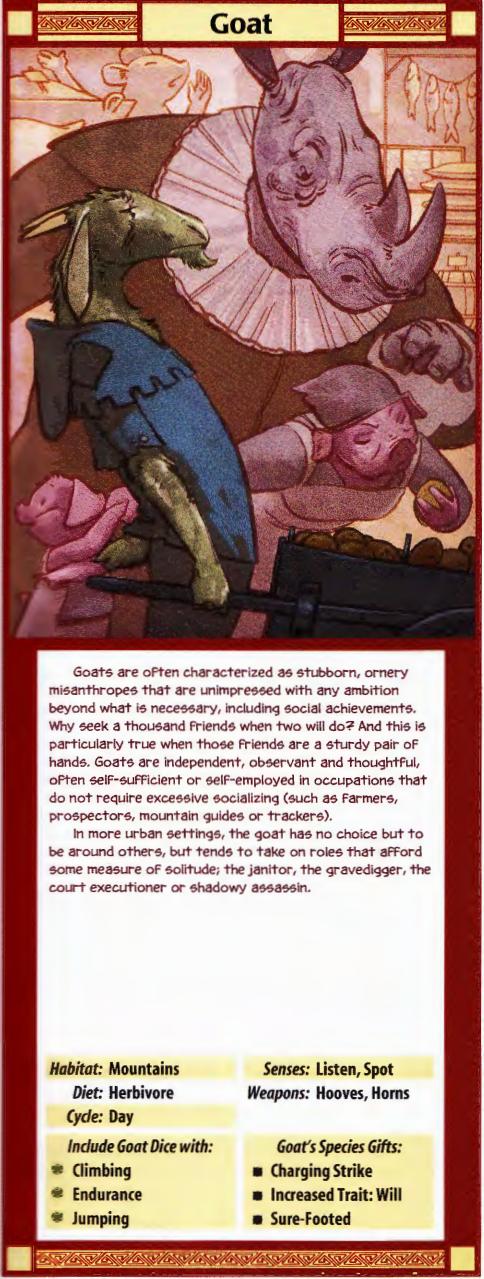
Goats
are stubborn loners who don't like being around other people. They aren't very ambitious and prefer stable, dull lives to exciting, unpredictable ones.
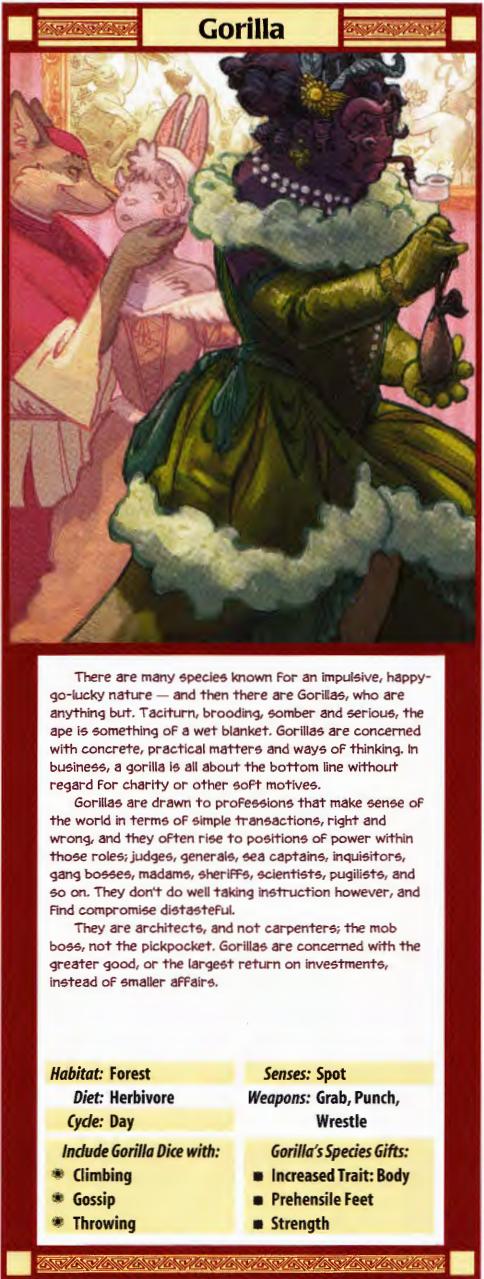
Gorrilas
are somber thinkers who excel at analytical thinking. They tend to be the planner behind things, rather than the doer themselves.
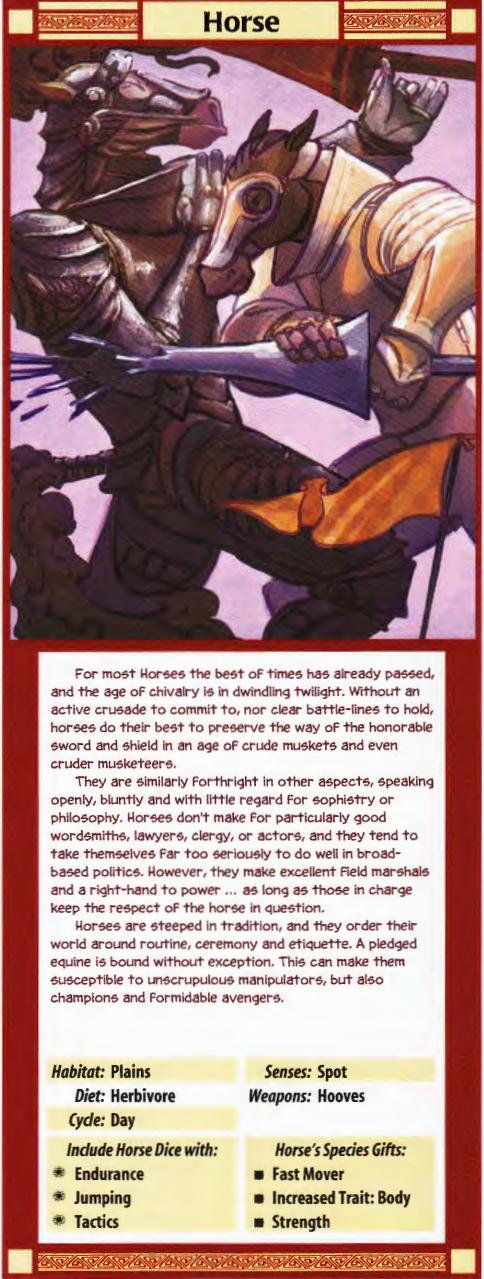
Horses
are classical knights that have survived beyond their age, trying to maintain chivalry and honour in a world that is forgetting them. In the setting, one of the major kingdoms (the Avoirdupois) is governed by horses.
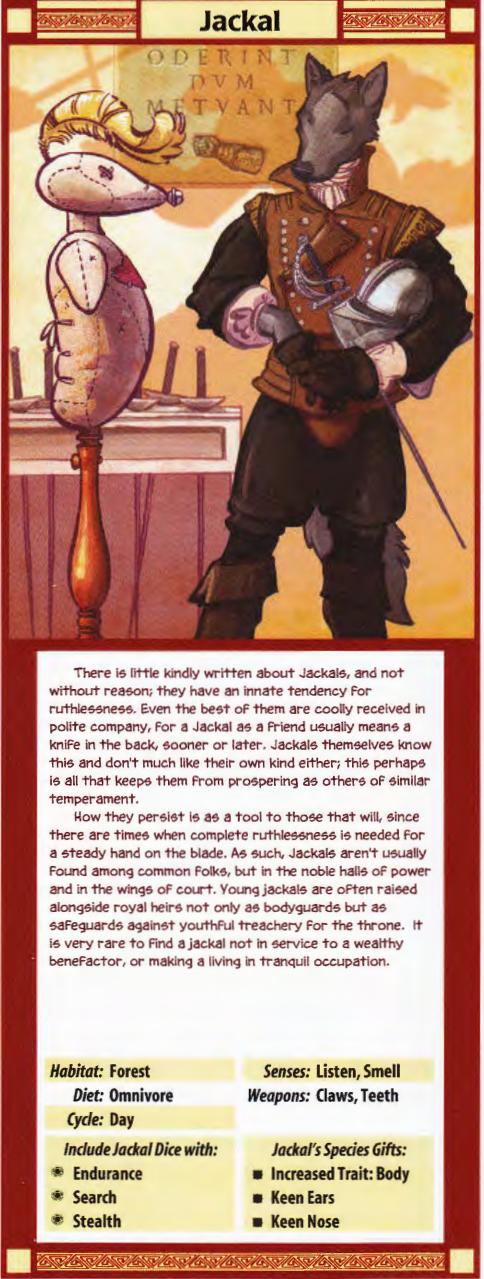
Jackals
are calculating, ruthless backstabbers. They serve as spies and bodyguards to the noble families and well-to-do people, and are rarely seen in other lines of work
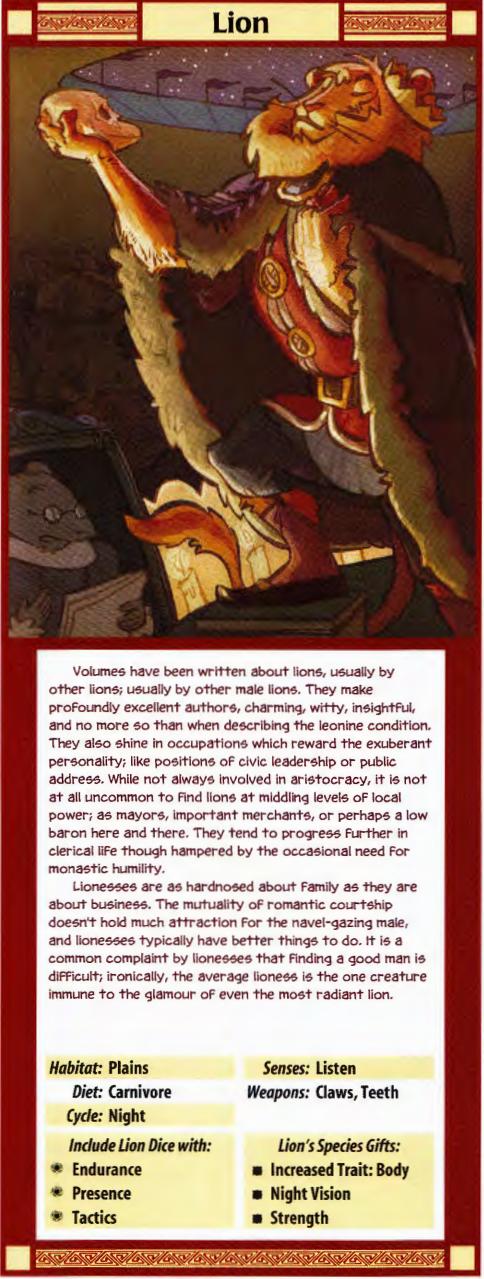
Lions
are great. The males are described as charismatic self-obsessed navel-gazers who cannot stop talking about themselves. Female lions have become pragmatic and blunt in response, to deal with the self-centredness of the males.
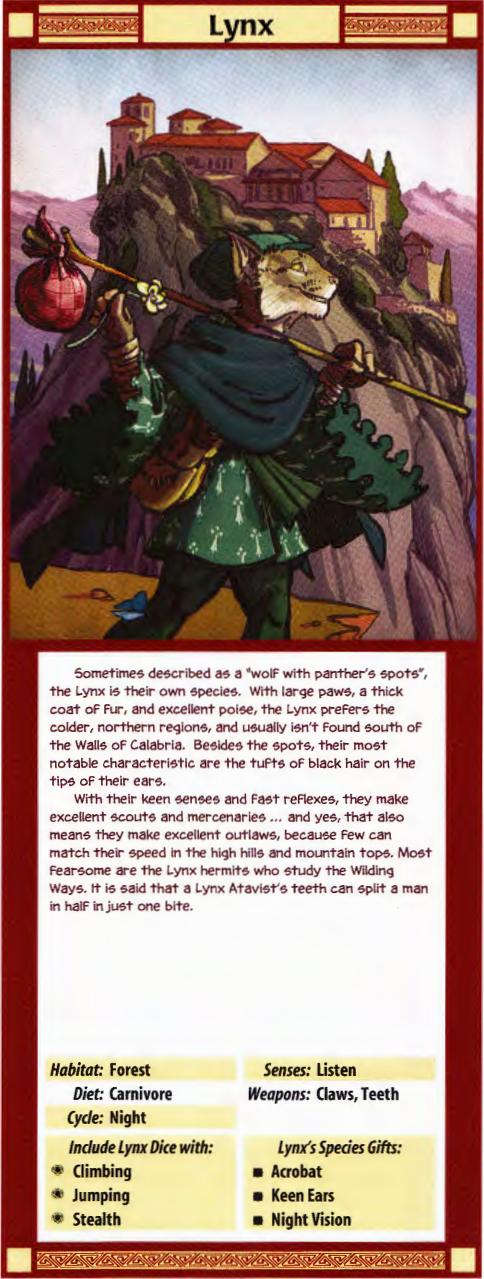
Lynx
are fast creatures that prefer northern climates. They excel as scouts.
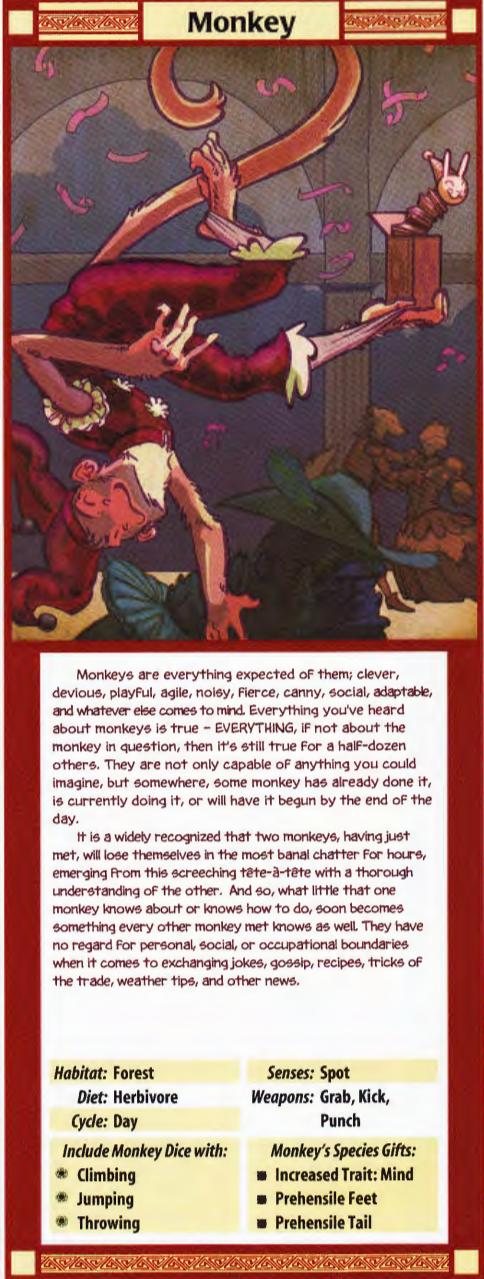
Monkeys
are crazy, boisterous jesters who try anything and everything. They gossip and talk to one another constantly, so that if one monkey knows, they'll all know soon enough. They're skilled with their hands and enjoys jobs that require crafting or making things.
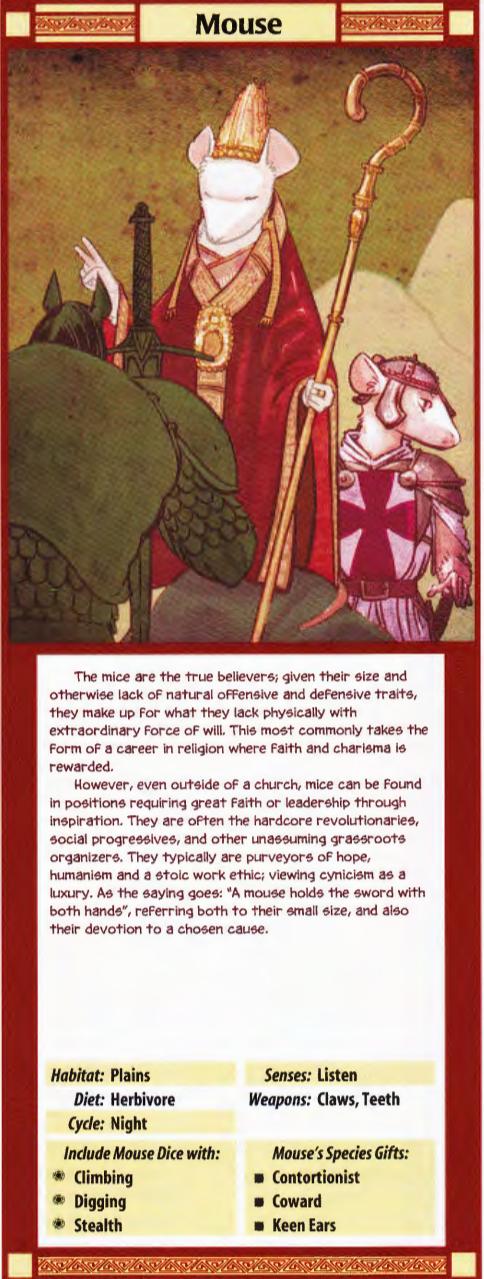
Mice
are the true believers of the Church of S'allumer, the main religion of the setting. Mouse Bishop makes me laugh. They also make god revolutionaries, protestors, or anything else that requires strong conviction and faith.
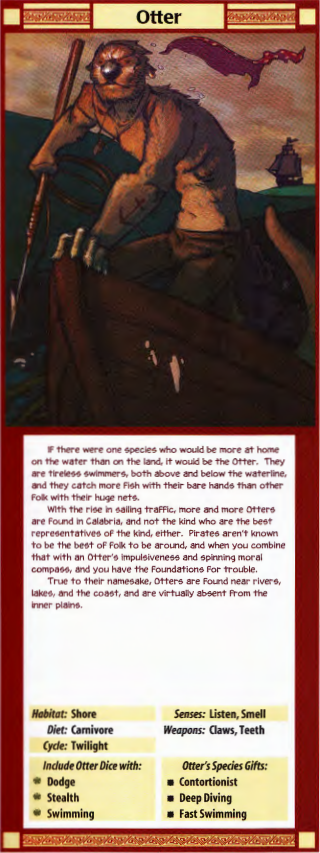
Otters
are the seafaring race, the only one of all the species to have fast swimming gift .
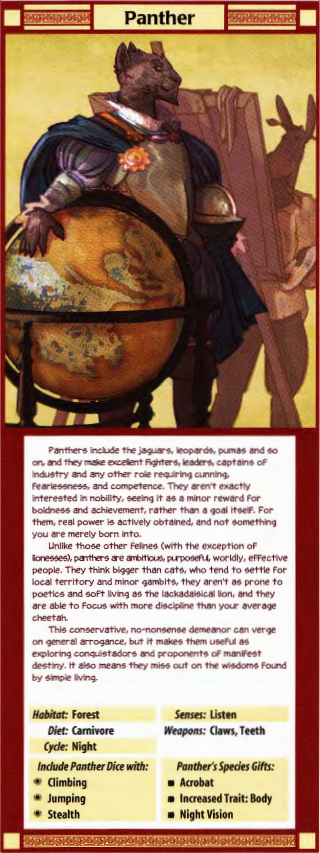
Panthers
are arrogant and ambitious power-seekers.
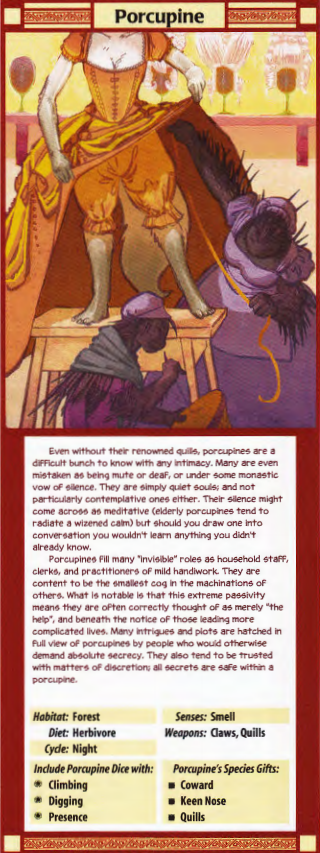
Porcupines
are quiet and introspective. They also have awesome natural weapons, of course.
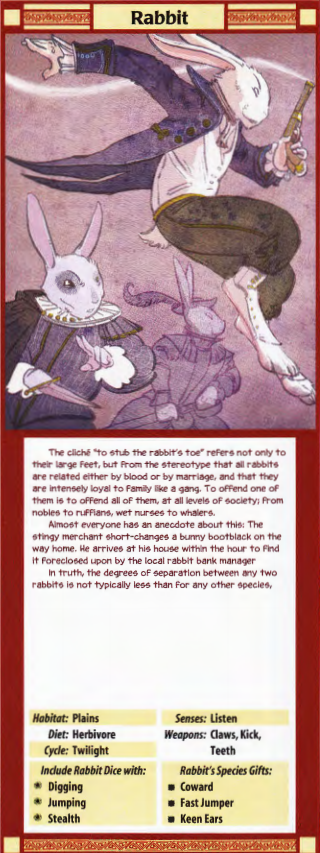
Rabbits
are rumored to all be part of the same extended family, and an offense against one, even of low station, can come back to bite someone in the ass as another rabbit (even of high station) takes revenge.
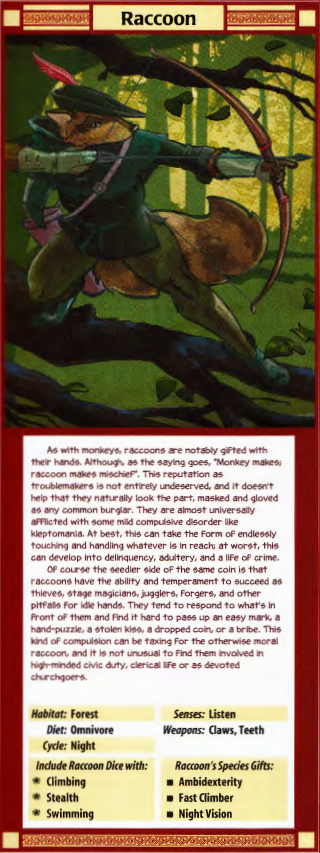
Racoons
loves stealing things. They are always touching and handling everything in sight.
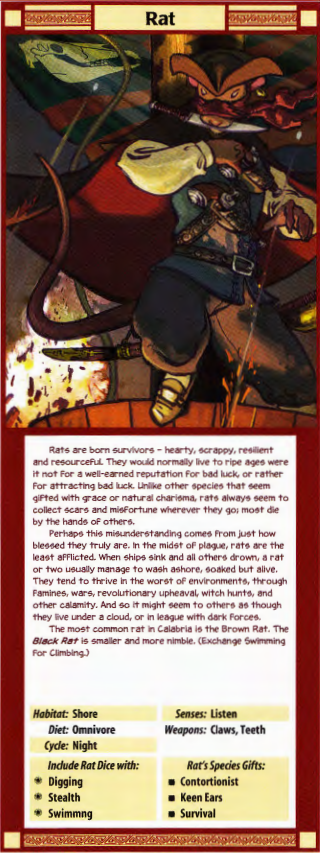
Rats
are scrappy survivors who have a reputation of bad luck, mostly because they are actually the only ones to survive things like plagues or sinking ships, and so are the only ones available to recount about it. Black Rats are a variant that gets swimming as a racial skill.
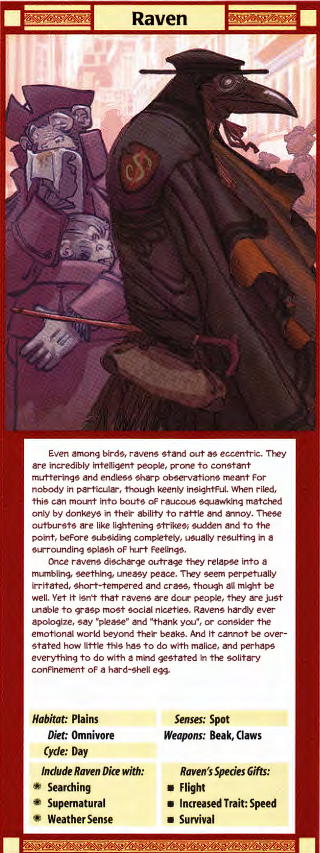
Ravens
are my favorite. They are short-tempered eccentrics that are always muttering to themselves. Classic mad scientist types, they have no time for social niceties.
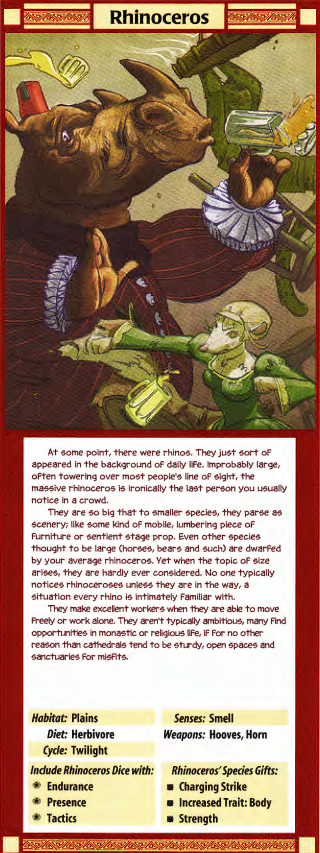
Rhinoceros
usually blend into the background, despite being the largest species. This is because, for many of the smaller species, Rhinos are so large that they read as part of the scenery.
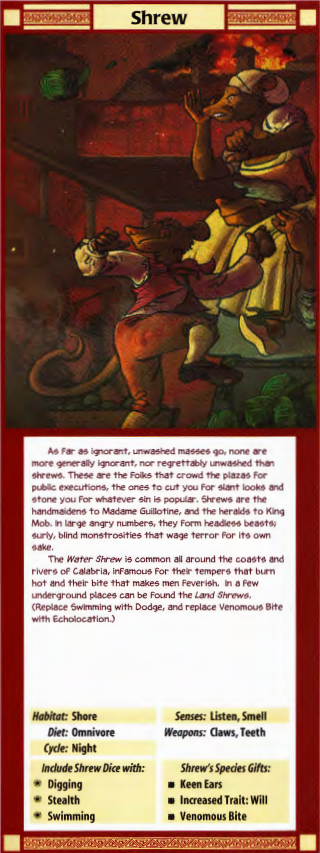
Shrews
are literally the "ignorant, unwashed" masses that make up mobs. They like attending public executions and stoning. Like rats they have a water variant that gets swimming as a racial skill.
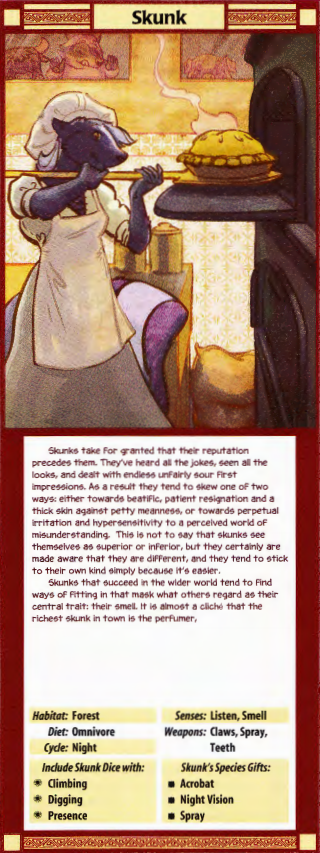
Skunks
are defined by how people react to their smell.
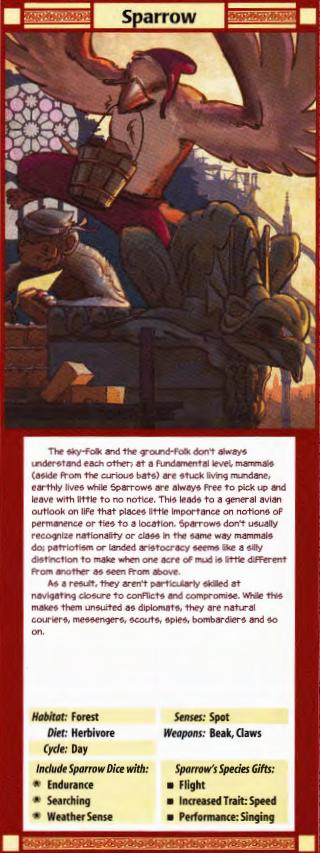
Sparrows
are wanderers, not really being tied to city or nation like other animals are. If problems appear in one area, they simply move somewhere else.
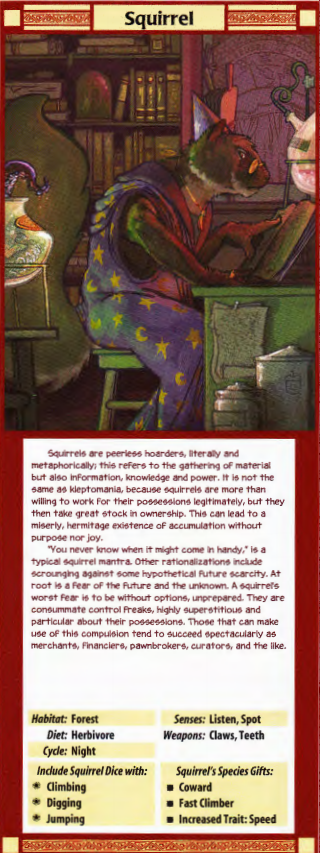
Squirrel
are hoarders and control freaks.
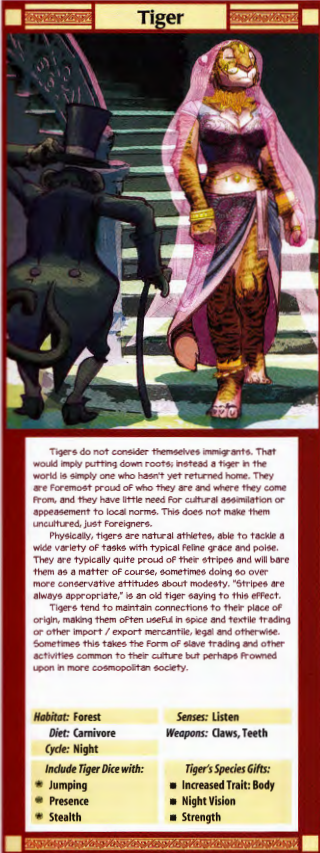
Tigers
are aristocratic travelers who maintain ties to their homeland.
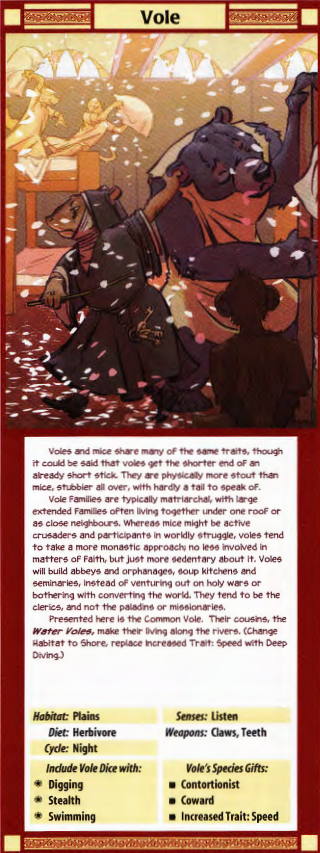
Voles
are like mice, but shorter and stubbier. They are matriarchal, and tend towards a more sedate, monastic piety, versus the angry crusades mice go on. Variant: Water Vole, which gets deep diving instead of speed
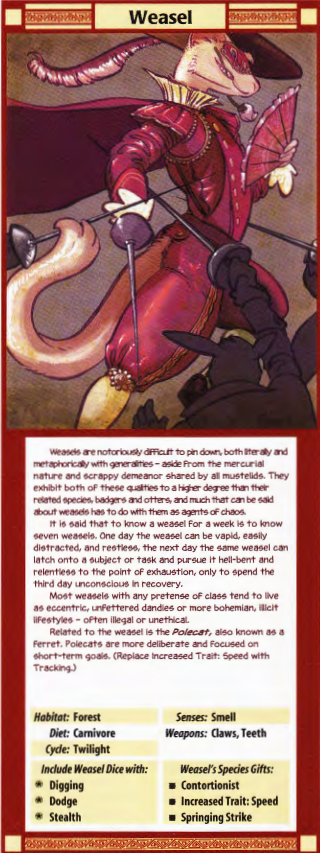
Weasels
are dashing rogues that are hard to read and understand. Variants: Polecat, which get tracking instead of a bonus to speed
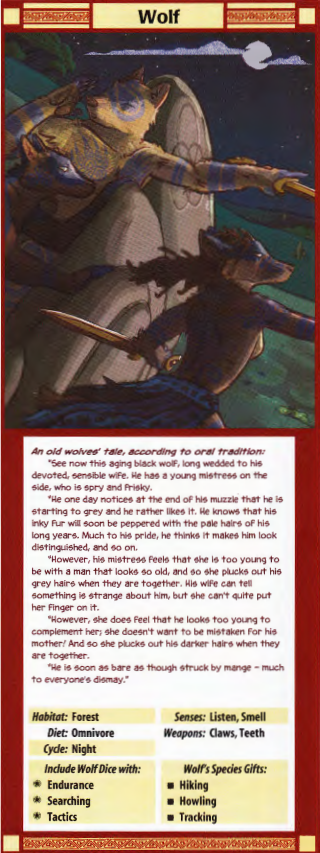
Wolves
are basically Celts, right down to the woad body-paint.
Next up comes careers:
Each career is very similar to a species, in that it comes with a set of three gifts and three skills, to which you get to add you career dice. I'm just going to list them quickly because the titles are basically self-explanatory, and the class system in this game is extremely simple. Each career also has a little Icon indicating what sort of role the career fits:
 Almoner
: Practitioner of the main faith of the setting. White Magic user who is good at healing.
Almoner
: Practitioner of the main faith of the setting. White Magic user who is good at healing.
 Bawd
: Basically a pimp and/or prostitute. It's less explicit than that in the book, but it basically says they "know where all the dirty goings-on in the city are, and [are] willing to entertain… for a price". They also come with cheap make-up and cologne as starting items.
Bawd
: Basically a pimp and/or prostitute. It's less explicit than that in the book, but it basically says they "know where all the dirty goings-on in the city are, and [are] willing to entertain… for a price". They also come with cheap make-up and cologne as starting items.
 Bodyguard
: also doubles as a bouncer.
Bodyguard
: also doubles as a bouncer.
 Bounty-Hunter
: Self-explanatory.
Bounty-Hunter
: Self-explanatory.
 Burglar
: Pretty much the thief half of the rogue archetype from D&D. Breaks into places, steals things, leaves without getting caught, etc.
Burglar
: Pretty much the thief half of the rogue archetype from D&D. Breaks into places, steals things, leaves without getting caught, etc.
 Charlatan
: The other half of the rogue archetype, this is the huckster who peddles useless charms and cures to the masses.
Charlatan
: The other half of the rogue archetype, this is the huckster who peddles useless charms and cures to the masses.
 Dilettante
: A wealthy noble who spends their time drinking and partying instead of getting a real job.
Dilettante
: A wealthy noble who spends their time drinking and partying instead of getting a real job.
 Dopplesöldner
: Two-handed warriors who fight on the Front lines in battle.
Dopplesöldner
: Two-handed warriors who fight on the Front lines in battle.
 Elementalist
: From Dunwasser College in the city of Triskelon, these are wizards who specialized in the four basic elements, in addition to super-powerful star magic.
Elementalist
: From Dunwasser College in the city of Triskelon, these are wizards who specialized in the four basic elements, in addition to super-powerful star magic.
 Explorer
: Self-explanatory. Think Magellan.
Explorer
: Self-explanatory. Think Magellan.
 Knight-Errant
: A noble Knight who has been forced to mercenary work to survive
Knight-Errant
: A noble Knight who has been forced to mercenary work to survive
 Mercenary
: Self-Explanatory.
Mercenary
: Self-Explanatory.
 Messenger
: Couriers who carry messages between towns
Messenger
: Couriers who carry messages between towns
 Paladin
: Warriors dedicated to fighting supernatural evil on behalf of the church
Paladin
: Warriors dedicated to fighting supernatural evil on behalf of the church
 Pit Fighter
: Gladiators. Technically illegal in most of the setting, so more like illegal boxing form Victorian England.
Pit Fighter
: Gladiators. Technically illegal in most of the setting, so more like illegal boxing form Victorian England.
 Rake
: Another sort of rogue, who enjoys partying and having a good time, but always has to stay one step ahead of their creditors.
Rake
: Another sort of rogue, who enjoys partying and having a good time, but always has to stay one step ahead of their creditors.
 Ranger
: The real meaning of this word, a watchmen and agent of the law over wide swaths of otherwise wild territory.
Ranger
: The real meaning of this word, a watchmen and agent of the law over wide swaths of otherwise wild territory.
 Scout
: Self-Explanatory.
Scout
: Self-Explanatory.
 Soldier
: Self-Explanatory.
Soldier
: Self-Explanatory.
 Sorcerer
: Practitioners of "Green & Purple Magic" (more on those later) who can read people's minds and learn their secrets
Sorcerer
: Practitioners of "Green & Purple Magic" (more on those later) who can read people's minds and learn their secrets
 Spellbinder
: Like a Sorcerer, only uses his magic to control weaker minds.
Spellbinder
: Like a Sorcerer, only uses his magic to control weaker minds.
 Thaumaturge
: Practices the "purest form of magic", involving luck, fate and natural flows of energy.
Thaumaturge
: Practices the "purest form of magic", involving luck, fate and natural flows of energy.
 Vagabonds
: Suffer from waderlust. Seek out adventure wherever they go.
Vagabonds
: Suffer from waderlust. Seek out adventure wherever they go.
 Warlock
: An elementalist who focused on magic for battle, instead of theory.
Warlock
: An elementalist who focused on magic for battle, instead of theory.
Going back to my example character, I'll choose to make her a Raven, which aids her for using wind magic. So My character is a Raven elementalist with the following:
Habitat: Plains
Diet: Omnivore
Cycle: Day (I forgot to mention in the last post, but cycle controls when certain abilities refresh)
Senses: Spot
Natural Weapons: Beak, Claws
Skills that get Species Dice: Searching, Supernatural, Weather Sense
Species Gifts: Flight, Increased Trait: Speed, Survival
Skills that get Career Dice: Academics, Observation, Supernatural
Career Gifts: Elementalist's Trappings, Elemental Apprentice, Literacy
Starting Equipment: Dioptra Rod (Damage+2, Parry d12), Leather Armour (d6), knife, first aid kit
Body
: d4
Mind
:d6
Speed
:d10 (upgraded due to Increased Trait: Speed)
Will
:d6
Species
:d6
Career
:d8
After picking a Species and Career, you also choose a
Personality,
that will serve as your personality gift. This will grant you a bonus d12 in situations where your personality would affect your actions. When this applies is ruled by the GM. Little things like this make Ironclaw a fun system, because your character's persona actually has an effect on game mechanics. A sample list of personalities is given; things like Humble, Kind, Greedy, Melancholic, Selfish, etc. The book also suggests using the four humours or the 7 Virtues and Sins form Dante as possible choices.
You then get to pick a starting
Local Knowledge.
This is the region where your character is from, and you receive a bonus d12 to knowledge checks in or about that region. This can usually be a town or general area, but in the case of Triskellon, you must specify with district of the city you come from. Local knowledge to a different region can be retrained using experience.
Next, we choose
Skills
. You start the game with 13 Skill marks to distribute, but can put no more than 3 marks into a given skill during character creation. Marks are like D&D ranks, except they follow this progression:
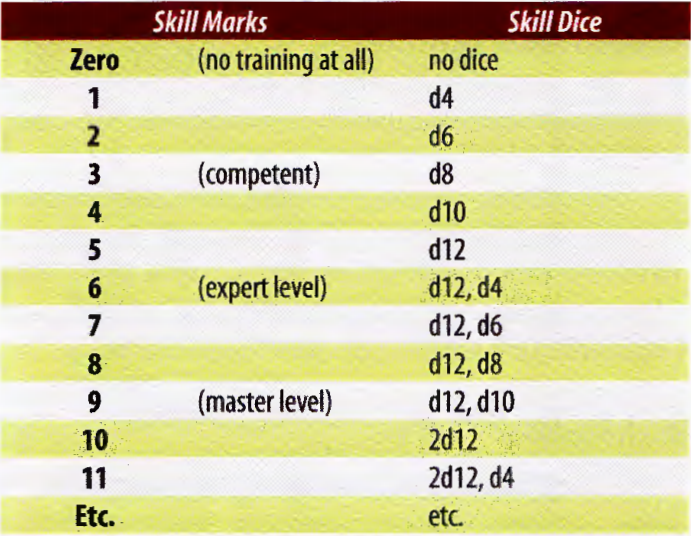
Basically it's a d12 for every five marks, with d4 through d10 corresponding to the 1 to 4 marks in between. Skills, also like D&D skills, get a trait (Body, Mind, Will, Speed) associated with them, adding your trait dice to your dice pool for the skill.
You then choose
Three Gifts
, assuming you meet the prerequisites. Gifts are like feats in D&D, except they are much more general and cover things like natural gifts, such as the Raven's ability to fly.
Now comes
Name
. The book contains some fluff about period and region/species appropriate naming.
Next you choose a
Motto
. Like the personality dice above, this motto affects game mechanics in that you can earn bonus experience if the GM feels you took actions in line with your Motto.
Then you choose a
Starting Goal.
Goals are kind of like quests in a standard RPG, things you need to do or accomplish to earn experience. After the initial goal you pick, subsequent goals are assigned by the GM as the story progresses. The initial goal should be something generic and generally easy to fulfill, like "Get paid" or "Defeat an opponent in combat".
Following this, you get your starting equipment, determined by your career and any "Trappings" gifts you have. You can also start with up to 8 stone of cheap or average equipment. In addition, you start with money equal to your maximized career dice, so in the case of my character, 8 denarri (the standard currency of the setting).
Lastly is determining you Battle Array, which is all different stats you'll need for combat:
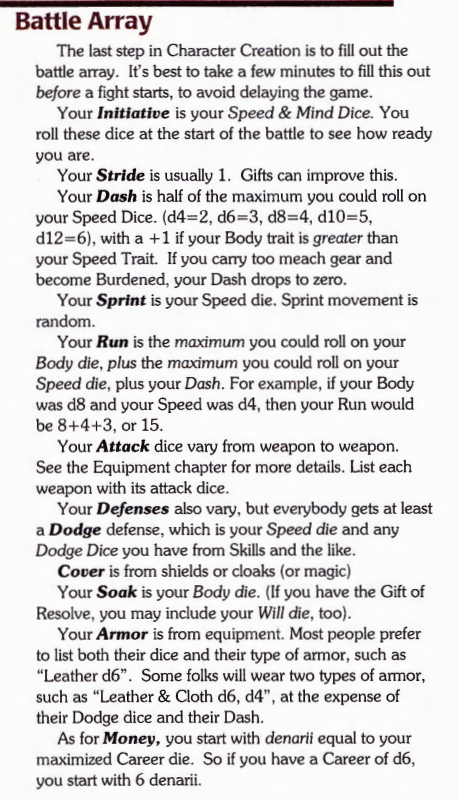
Next Time, I'll go through the skills and gifts available!
Also, for the sake of the wiki, here's a link to my other post about Ironclaw that wasn't really a part of my write up, explain the skill check system:
http://forums.somethingawful.com/sh...7#post403981705